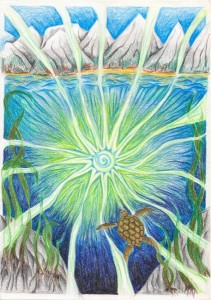
Why Should we Meditate on Gratitude? What are we Trying to Achieve?
The function and purpose of meditating on gratitude is to train our attention in such a way that even when we are under pressure and feeling unhappy in some way we never lose sight of the things in our life that are there for us to appreciate, value and feel grateful for. Moreover, when we are not feeling unduly under pressure or unhappy, the practice of gratitude helps us to substantially enhance and stabilize our happiness and sense of wellbeing.
Meditating on gratitude is a way of leveraging more fully upon the existing good in your life. By consciously noting and appreciating that which is there to be thankful for, the amount of happiness that you get from that person, object of event increases exponentially. Whenever we take someone or something/someone for granted we minimize the amount of wellbeing that we can derive from our relationship to it or them.
Success in Meditating on Gratitude.
One of the main signs of success in our meditation on gratitude comes when we start to realize that there is something that we can be appreciating and feeling happy about in each and every moment of our life. There is in fact an abundance of things to feel positive about in everyone’s life, it is just a matter of training our attention through meditation to be aware of it!
Our biological brain is hardwired toward picking our faults, threats and dangers in our life. This was good for our survival when we were fighting of bears and tigers and other tribes, but in today’s modern world this tendency to pick out the negative serves most often to inhibit our quality of life and constrict the amount of potential happiness that we experience at any given moment. The meditation on gratitude is designed t remedy this issue.
How to Meditate on Gratitude.
The perception can be that meditation is an activity that you do sitting down in silence, and then once you get up you then start doing something else. In reality however good meditation involves training our attention through-out the day to focus on objects that make us calm, peaceful and happy.
Correspondingly this meditation in gratitude is something that you can in the midst of your daily activities in spare moments.
The Basic Practice:Finding short periods of time to come back to a mind of gratitude and appreciation.
Think about the way in which your day is structured and try and come up with 5-6 one minute slots where you can consciously come back to a mind of gratitude, and focus on it for just that very short period of time. By doing this over the period of the week you will start to create some strong practical habits in your mind that naturally incline toward valuing, appreciating and feeling grateful for the good in your life.
What Should I feel Grateful For?
There are almost innumerable things that we can choose to be grateful for, three main areas are:
– Gratitude appreciation for ourself and our own actions. Give yourself a regular pat on the back for the positive efforts you are making!
– Gratitude and appreciation for others in our life who help or assist us in some way.
– Gratitude and appreciation for the Earth, for nature and the opportunity to participate in life
Some Samples From my own journal
Of course there are many other different things that we can focus on as objects of gratitude and rejoicing. One thing that I find really powerful is actually writing down the thing that I am feeling grateful for, either actually at the time or later in the day. Writing down our object of gratitude makes it really stand out in the field of our awareness, and therefore has a powerful and accelerated effect upon our development of gratitude (and yes, writing can be very much a part of our meditation practice!).
Here are some examples from my own journal over a twenty four hour period:
9th September
3.15pm – I am waiting for my daughters’ bus to arrive, there is a pleasant breeze blowing through the bushes and flowers, the sky is cool and overcast. Next to me on the wall a little family of sparrows observes me closely whilst preening themselves. I take a moment to appreciate and soak in all of these gifts from the natural world, freely available to me as long as I care to notice.
6.15pm – Whilst waiting at the bus stop on the way to the shopping centre I took a minute to appreciate the trees around me, and the calming energy that they gave me at a time when I was feeling a little bit irritable. I also took the time to notice the sun setting behind the clouds and value how pleasant it can be to view the light of the sun when it is hidden behind light cloud.
9.30pm – Took time after my evening meditation to appreciate myself for making the time and effort to meditate. I also spent a short period of time enjoying and appreciating the evening moon and its cooling and calming light!
12.30am – Reflected on the enjoyment that both I and my daughter are getting from reading “The Lion, the Witch and the Wardrobe” together each evening.
10th September
8.30am – Took a few moments whilst watering the plants on our roof to appreciate and feel gratitude for the good energy that they give to us and the way in which they visually enhance our living space.
11.15am – Spent a few moments appreciating myself for having done the vacuuming and other cleaning tasks around the house, as well as feel grateful to the makers of the vacuum cleaner for saving me time by making such an effective machine! Finally felt grateful for our pleasant apartment.
2pm – Felt gratitude for the excellent Japanese vegetarian meal that I had just participated in, and for the efforts of the people who had created such an excellent alternative Japanese vegetarian restaurant!
4.15pm – After spending an hour taking research photos for my new project, I took a moment to feel grateful for the fact that I have such a relatively large amount of time to devote to my artistic practice in my life.
As you can see none of the above are hugely unusual or remarkable events. Enjoying the daily happiness that gratitude can give is simply a matter of training your attention to look in the right directions every day!
© Toby Ouvry 2011, you are welcome to use or share this article, but please cite Toby as the source and include reference to his website www.tobyouvry.com
 Normally when we think about anxiety and its causes things such as money, relationships, negative emotions and the like come to mind as primary causes of our mental anxt. However what about freedom?
Normally when we think about anxiety and its causes things such as money, relationships, negative emotions and the like come to mind as primary causes of our mental anxt. However what about freedom?







